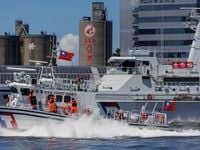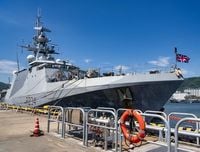In a significant escalation of military activity in the Taiwan Strait, China has deployed an unprecedented number of warplanes and naval vessels around Taiwan over the past several days, intensifying tensions in the region. Between late Thursday, June 19, and early Friday, June 20, 2025, Taiwan’s Defense Ministry reported that 74 Chinese warplanes were sent toward the island, with 61 crossing the central line that unofficially divides the strait. These aircraft arrived in two distinct waves, accompanied by six Chinese naval ships, including drones, fighter jets, early warning, and support aircraft.
This surge in Chinese military presence follows closely on the heels of several high-profile naval transits by Western allies through the Taiwan Strait, a strategic waterway that China claims sovereignty over but which many countries, including Taiwan, the UK, the US, and Japan, regard as international waters.
On June 18, 2025, the British Royal Navy’s offshore patrol vessel HMS Spey sailed through the Taiwan Strait. Taiwan’s Ministry of Foreign Affairs confirmed and welcomed the transit, stating it “once again reaffirmed the Strait's status as international waters.” The British Office in Taipei emphasized that the Spey’s navigation complied fully with international law and the United Nations Convention on the Law of the Sea, asserting the Royal Navy's right to freedom of navigation and overflight wherever it operates.
China’s Eastern Theater Command of the People’s Liberation Army (PLA) responded with sharp criticism, accusing the British ship of deliberately disturbing the situation and undermining peace and stability in the Taiwan Strait. The command said it organized troops to monitor and guard the entire process, effectively responding to the transit. This reaction is consistent with Beijing’s long-standing posture of opposing foreign military presence in the strait, which it regards as its sovereign territory despite never having ruled Taiwan.
The British transit was not an isolated event. Earlier in June, on the 12th, the Japanese destroyer JS Takanami passed southward through the Taiwan Strait, a move tracked and monitored by the Chinese military. The Japanese ship’s passage lasted over 10 hours as it moved from the East China Sea to the Philippines, where it participated in drills in the South China Sea. Japanese media reported that this was the third known transit of the strait by Japan’s navy, with previous passages in September 2024 and February 2025. The Japanese government, however, does not officially acknowledge these transits.
These naval maneuvers by the UK and Japan follow a pattern of increasing Western military activity in the region. Earlier this year, a Canadian warship and multiple US naval vessels also transited the strait, reinforcing international assertions of freedom of navigation. The British patrol vessel HMS Richmond previously sailed through the strait in September 2021, underscoring a continued Western naval presence in the Indo-Pacific.
Meanwhile, Taiwan’s Defense Ministry has been closely monitoring Chinese military activity around the island. In the 24 hours leading up to June 20, 2025, the ministry detected more than 70 Chinese military aircraft, including 50 aircraft and six naval vessels by 6 a.m. Friday, followed by an additional 24 aircraft, including fighters and drones. Of those, 15 crossed the median line of the Taiwan Strait to conduct air-sea joint training exercises with Chinese naval vessels. Taiwan responded by deploying its own ships, fighter interceptors, and land-based missile systems to counter the incursions.
The recent Chinese air and naval deployments represent the highest number of warplanes sent toward Taiwan since October 2024, when China staged large-scale military drills following a speech by Taiwan’s President William Lai Ching-te. The October exercises saw 153 Chinese aircraft around Taiwan, a record high. The current surge follows US lawmakers’ visit to Taiwan and the recent naval transits by the UK and Japan, moves China views as provocative.
Senior Captain Liu Runke, navy spokesperson for the PLA Eastern Theater Command, reiterated China’s readiness to counter any threats. “The troops of the PLA Eastern Theater Command will remain on high alert at all times and resolutely counter all threats and provocations,” he said in a statement on June 20, 2025.
Taiwan’s Foreign Ministry has urged like-minded countries to continue defending peace and stability in the Taiwan Strait and to promote a free and open Indo-Pacific region. The ministry emphasized that such international naval transits uphold the rules-based international order and discourage unilateral attempts to alter the status quo by force.
As tensions simmer, the Taiwan Strait remains a focal point of geopolitical rivalry between China and the United States and its allies. Beijing’s insistence on sovereignty over Taiwan and the surrounding waters clashes with the strategic interests of countries committed to maintaining open sea lanes and supporting Taiwan’s democratic self-rule.
Looking ahead, it remains uncertain whether more countries will join the increasing naval presence in the region or how China might further respond. The recent military maneuvers underscore the fragile balance in the Indo-Pacific, where freedom of navigation, territorial claims, and alliance commitments intersect in a complex and often volatile dance.
For now, the skies and seas around Taiwan are crowded with military activity, a vivid reminder that the island’s security remains a critical and contentious issue on the world stage.





